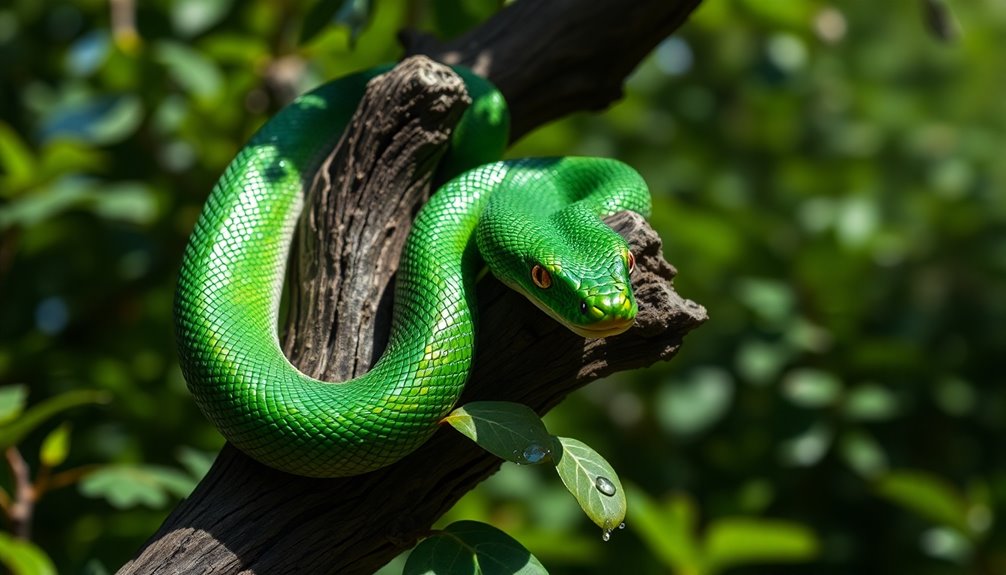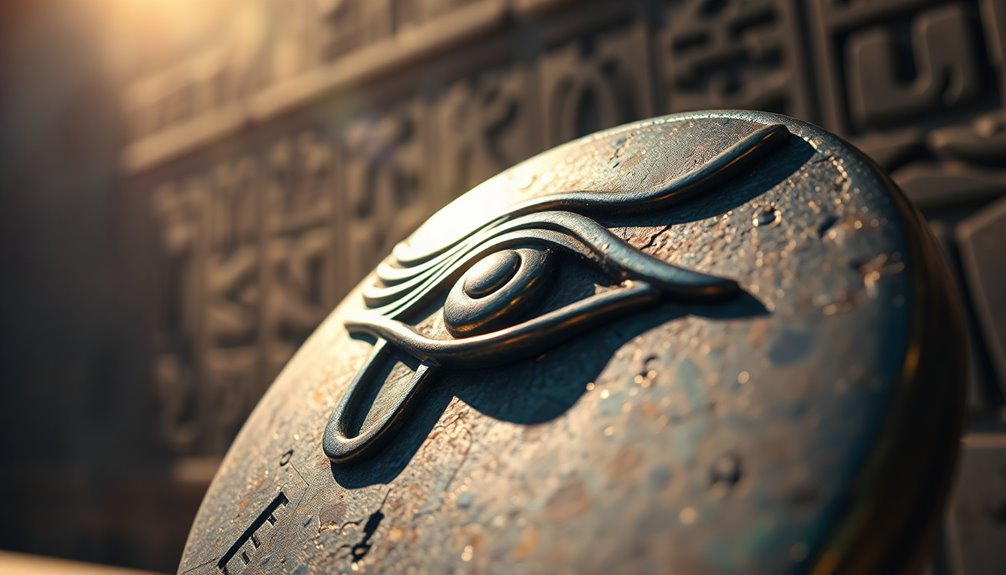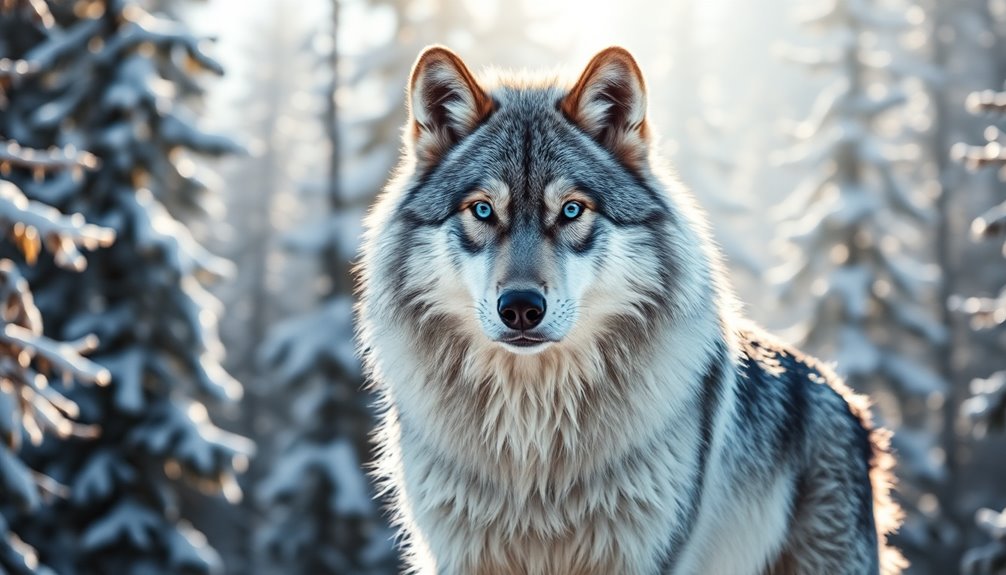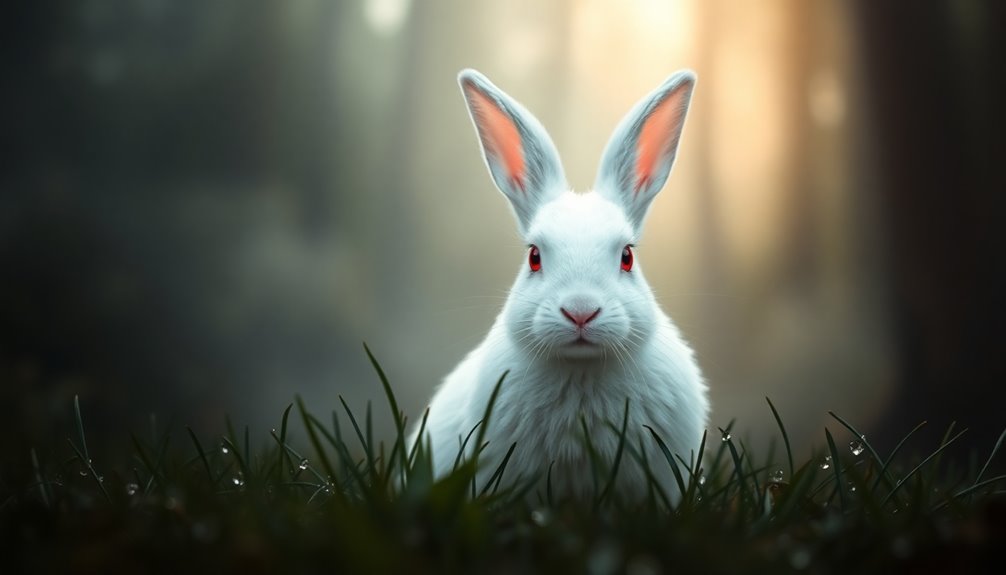Snakes are fascinating symbols that represent many things around the world! They often stand for transformation and healing, as they shed their skins and grow anew. In some cultures, snakes symbolize wisdom or protection, like the Egyptian cobra. They can also show both good and evil, reminding us of the balance in life. Some people fear snakes due to warnings in stories, but understanding them can help reshape those feelings. Plus, their presence in art and mythology sparks curiosity and insight. Isn't it exciting that each culture has its unique view on snakes? You'll discover even more amazing meanings!
Key Takeaways
- Snakes symbolize duality, representing both good and evil, temptation, and desire across various cultures.
- The shedding of a snake's skin signifies rebirth, transformation, and personal growth.
- In many traditions, snakes embody life, renewal, and fertility, contributing to their symbolic richness.
- Snakes are often seen as guardians, protecting sacred spaces and representing wisdom in various mythologies.
- The Ouroboros, a snake eating its own tail, symbolizes eternity and the perpetual cycle of life and death.
Evolutionary Origins

When you explore the evolutionary origins of snake symbolism, it's fascinating to see how these creatures have influenced human development over millions of years. Snakes have been predators of primates for a long time, shaping our fear responses. This fear, known as ophidiophobia, is one of the most common phobias worldwide. It makes sense—our ancestors faced real dangers from snakes, and this instinct has carried over through generations.
Serpent symbolism appears in myths all around the world, often representing both danger and death. This connection might come from our evolutionary past, especially with venomous snakes that could harm us.
Yet, snakes also symbolize more than just fear; they represent good and evil, initiation, and rebirth. Some ancient cultures even linked snakes to significant elements like rain and water, which were vital for survival.
As you dive deeper into these themes, you'll see how snakes have shaped not just our fears, but also our stories and beliefs. Understanding these evolutionary origins helps you appreciate the rich tapestry of meanings that snake symbolism holds in our lives today.
Cultural Values
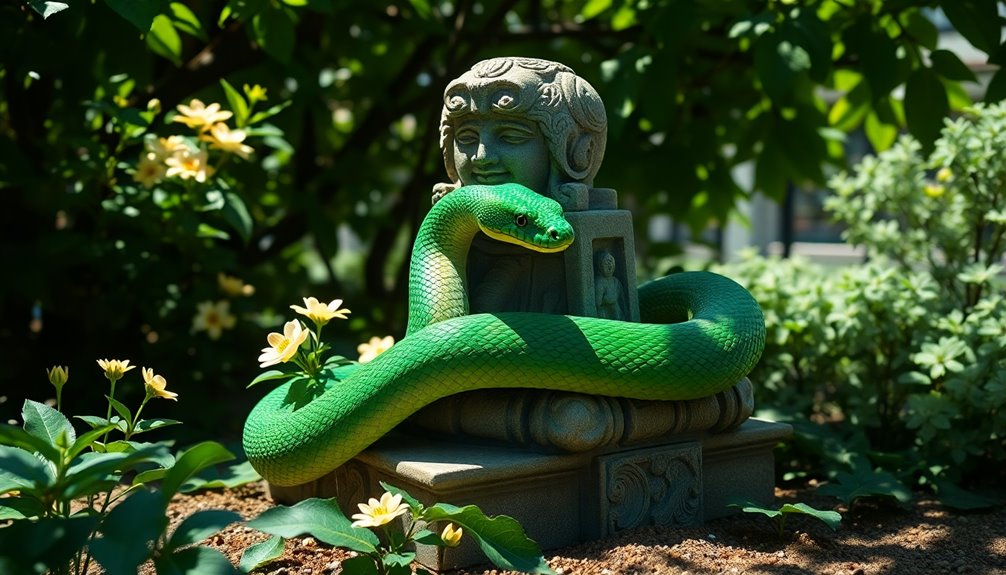
Throughout history, snakes have played a significant role in shaping cultural values across various societies. The symbolism of the snake is rich and diverse, often reflecting ideas of life and renewal. In many cultures, snakes are ancient symbols of fertility and the creative life force. They remind us of the power of nature and the cycles of life.
One fascinating aspect is how snakes shed their skin, which people see as a sign of rebirth and transformation. This process represents not just physical change but also personal growth. The Ouroboros, a snake eating its own tail, beautifully illustrates the idea of eternity and the continual renewal of life. It teaches us that change is a natural part of existence.
However, snakes also have a dual nature. In some Abrahamic traditions, they're linked to temptation and desire, showing that they can represent both good and bad.
In Hinduism, the Kundalini energy is visualized as a coiled serpent, symbolizing the awakening of spiritual consciousness. This mix of meanings helps us understand the complex cultural values that snakes hold in our world.
Guardianship Roles

Snakes are fascinating creatures that often take on guardianship roles in different cultures.
Did you know that in Buddhism, multi-headed nāgas protect temples, showing how strong and watchful these snakes can be?
Plus, when snakes feel threatened, they display defensive behaviors that remind us of their natural instinct to guard their territory!
Sacred Space Protectors
In many cultures, the symbolism of snakes as guardians of sacred spaces reveals their deep-rooted connection to protection and spirituality. You might see them in temple architecture or religious art, representing strong protective forces. Snakes, like the multi-headed nāgas in Angkor, are often seen as guardians of temples, showcasing their defensive power and divine qualities.
Here's a quick look at their roles:
| Snake Symbolism | Examples | Spiritual Significance |
|---|---|---|
| Guardians of Temples | Multi-headed nāgas | Protects spiritual practices |
| Protection | Mucalinda shielding Buddha | Represents inner peace and safety |
| Defensive Power | Rattlesnakes and cobras | Deterring threats from sacred areas |
These serpents reflect how essential protection is in spiritual spaces. The Gadsden flag, featuring a rattlesnake, shows how these creatures symbolize the fight for rights and freedom. So, snakes aren't just fascinating; they embody the essence of guardianship in sacred spaces, reminding us of their important roles in various cultures around the world!
Defensive Behavioral Traits
When faced with threats, many snakes display remarkable defensive behaviors that highlight their role as natural guardians. These behaviors can include hissing, rattling, or even striking to protect themselves and their territory. By acting as protectors, these serpents demonstrate their guardianship instincts, reminding us of their important place in nature.
In various cultures, snakes symbolize protection. For example, the multi-headed nāgas guard sacred temples in Angkor sculptures, showcasing the serpent's role as a guardian of sacred spaces.
Similarly, the Mucalinda, a serpent king in Buddhist tradition, sheltered the Buddha during meditation, further emphasizing the symbolism of protective guardianship.
Even in modern times, the rattlesnake embodies the spirit of resistance and defense, as seen on the Gadsden flag, which symbolizes the fight for rights and homeland.
The king cobra, with its impressive defensive postures, reinforces the idea of snakes as guardians in both ecological and cultural stories.
Venom and Healing

Did you know that snake venom can be both dangerous and helpful?
It's fascinating how this potent substance has healing properties and is used in medicine today!
From ancient practices to modern breakthroughs, snakes symbolize transformation and health in many cultures, making their story truly exciting.
Healing Properties of Venom
The healing potential of snake venom captivates researchers and medical professionals alike, as it holds promise for developing innovative treatments. Snakes, with their fascinating biology, offer more than just danger; their venom can be a source of healing!
For centuries, the Rod of Asclepius, featuring a snake wrapped around a staff, has symbolized the connection between snakes and healing. Asclepius, the Greek god of medicine, reminds us of this important link.
Certain snake venoms are being studied for their amazing abilities. They can help with pain relief and even regulate blood pressure. Isn't that incredible?
Some venoms may improve blood flow and reduce clotting, which could help treat conditions like stroke and heart disease. But wait, there's more! Research shows that specific peptides in snake venom might even slow down cancer cell growth, offering hope for new cancer therapies.
The Nehushtan, a bronze serpent mentioned in biblical texts, symbolizes healing too. It was used by Moses to cure the Israelites from snake bites.
Serpent Symbolism in Medicine
Serpent symbolism in medicine intertwines ancient beliefs and modern science, showcasing how snakes have long represented healing and wisdom.
Think about the Greek god of healing, Asclepius. He's often shown with a serpent-wrapped staff, a powerful symbol connecting healing to the wisdom of snakes. This image highlights how cultures have turned to snakes for guidance in health matters.
Did you know that some snake venoms have amazing medicinal properties? Scientists use certain components to create drugs that help with hypertension and pain relief. That's pretty impressive!
In the Bible, the Nehushtan, a bronze serpent, also served as a healing symbol, emphasizing how people have relied on snakes for health and recovery for centuries.
Today, many medical institutions use snake imagery in their logos. In fact, about 62% of them incorporate snake motifs to represent healing and medical practice.
This shows just how deep-rooted the symbolism of snakes is in healthcare. They're seen not just as creatures to fear, but as symbols of knowledge and healing. Furthermore, the application of intelligent tutoring systems in medical education can enhance the understanding of such symbolism among healthcare professionals.
Ancient Healing Practices
For thousands of years, ancient healing practices have harnessed the unique properties of serpent venom, viewing it as a powerful tool for treating various ailments. In ancient Egypt, the snake goddess was revered for her healing abilities. People believed that the venom of snakes could help cure diseases and protect against sickness.
The Greek god Asclepius, often shown with a serpent wrapped around his staff, symbolizes the deep connection between snakes and medicine. This image reminds us of how important snakes have been in healing practices for over 2400 years.
In the Bible, we find the story of the bronze serpent created by Moses. This serpent acted as a healing symbol, saving the Israelites from trouble. It shows the dual nature of snakes: they can be dangerous, yet also curative.
The Nehushtan, a serpent on a pole mentioned in Numbers 21:8, highlights this idea further. These ancient beliefs remind us that snakes aren't just symbols of danger; they also represent healing and protection.
Mythical Connections

Throughout various mythologies, snakes embody a rich tapestry of symbolism, often serving as conduits between the domains of wisdom and foresight. These fascinating creatures connect ancient gods and goddesses with the knowledge of good and evil. In many stories, snakes represent deeper truths, guiding seekers through their journeys.
Take the Greek seer Teiresias, for example. After striking serpents, he transformed into a woman and gained incredible insights. His story reminds us that snakes hold the power of transformation, allowing them to bridge the gap between different perspectives.
Serpents and snakes are often seen as symbols of life and death too, thanks to their ability to shed their skin. This act reveals a cycle of rebirth and renewal.
Across cultures, snakes embody wisdom. Their winding forms remind us of the mysteries of the natural world. They don't just slither; they inspire change and enlightenment.
When you think of snakes in mythology, remember their roles as powerful symbols. These creatures teach us about the complexity of knowledge and the importance of seeing things from different angles. Embrace the wonder of snakes and the mythical connections they represent!
Fear of Snakes

Many people experience an intense fear of snakes, known as ophidiophobia, which ranks among the most common phobias globally. This fear often starts in childhood. It's believed to come from our ancestors' experiences with dangerous, venomous snakes. This makes it more of an evolutionary response than something learned.
Cultural stories often make snakes seem scary. Think about ancient Egyptians who saw snakes as symbols of power and danger. Your feelings about snakes might be influenced by these stories, too!
Here's a quick comparison of ophidiophobia and other fears:
| Fear | Description |
|---|---|
| Ophidiophobia | Fear of snakes |
| Arachnophobia | Fear of spiders |
| Acrophobia | Fear of heights |
| Claustrophobia | Fear of confined spaces |
| Nyctophobia | Fear of the dark |
These fears, including the fear of snakes, connect to our natural instincts to survive. While modern dangers exist, our minds seem wired to remember ancient threats. Understanding this can help you tackle your fears and see snakes in a new light!
Symbolism in Art
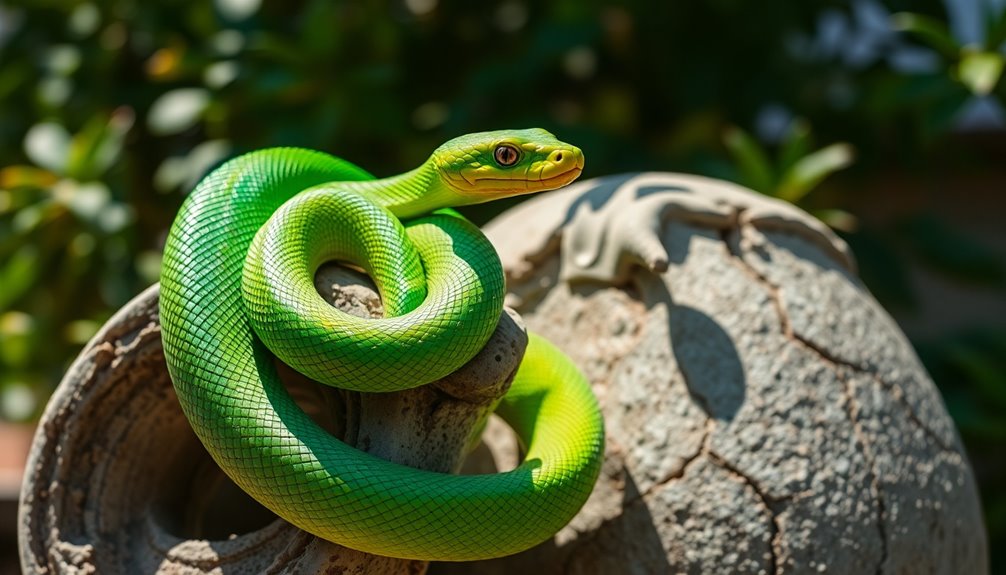
Snakes slither through the domains of art, embodying a complex blend of meanings that reflect the duality of human experience. They can be both dangerous and protective, showing how life can be full of contrasts.
Here are three important ways snakes appear in art:
- Symbol of Eternity: The Ouroboros, a serpent eating its own tail, represents the cycle of life and death, reminding us that everything is connected and always renewing.
- Feathered Serpent: In various cultures, like the Mexica, the feathered serpent showcases the link between the earth and the sky, emphasizing life and fertility.
- Artistic Representations of Good and Evil: In Renaissance art, you might see the Virgin Mary standing on a snake, symbolizing the triumph of good over evil. This shows how the serpent represents both danger and protection.
Through these artistic expressions, snakes invite you to explore deep meanings and emotions. Their presence in art sparks curiosity and wonder, making you think about the duality of life.
Isn't it fascinating how a simple creature can hold such powerful symbolism?
Cross-Cultural Interpretations

Across cultures, the symbolism of snakes weaves a rich tapestry of meanings that highlight their dual nature. You might find it fascinating how snakes can represent both good and bad.
In ancient Egypt, the Egyptian cobra symbolized wisdom and protection, especially through the goddess Wadjet, who safeguarded the pharaohs. Isn't it cool how a snake can embody such power?
In Norse mythology, the Midgard serpent, Jörmungandr, plays a significant role. It symbolizes the life-death cycle, and it's said to battle during Ragnarok, which adds an exciting twist to its meaning!
Hinduism adds another layer, viewing snakes as symbols of Kundalini energy. This energy signifies spiritual awakening and transformation, showing how snakes can help you discover your inner strength.
Then there's the god Quetzalcoatl from Mesoamerica. Depicted as a feathered serpent, he represents creation, fertility, and the life-giving power of nature.
With their ability to shed their skin, snakes remind us of rebirth and the chance to start anew, making them truly remarkable symbols in many cultures.
Isn't it amazing how one creature can carry so many meanings?
Notable Serpent Representations

One of the most intriguing serpent representations is the Ouroboros, a symbol that captivates with its imagery of a serpent eating its own tail. This ancient symbol represents eternity and the cycle of life, and you can trace its origins back to ancient Egypt and Greek mystery cults.
In many cultures, serpents hold powerful meanings. Here are three notable examples:
- Quetzalcoatl: In Mesoamerican mythology, this Aztec god takes the form of a feathered serpent. He embodies wind and rain, showing the balance between life and death.
- Medusa: From Greek mythology, she's famous for her snakes for hair! Medusa symbolizes transformation and punishment, as her gaze could turn people to stone.
- Naga: In Hindu and Buddhist traditions, these semi-divine beings often appear as half-human and half-cobra, linked to water and protection.
You might even find snake dances in North America that celebrate these fascinating creatures.
From the *Book of Genesis* to ancient tales, snakes have always sparked our imagination. Their rich symbolism reminds us of life's mysteries and wonders!
Frequently Asked Questions
What Do Snakes Mean Spiritually?
Snakes hold powerful spiritual meanings! They often represent transformation and renewal.
When a snake sheds its skin, it shows us that change can be beautiful and necessary. You might also see snakes as symbols of healing and wisdom, reminding you to trust your instincts.
In some cultures, they even represent spiritual awakening.
What Does a Snake Symbolize in the Bible?
So, in the Bible, snakes can be quite the characters! They often symbolize temptation and evil, like when the sneaky serpent tricks Eve in the Garden of Eden.
But wait, there's more! Snakes also symbolize healing, like when Moses lifts a bronze serpent to help the Israelites.
What Does the Snake Symbolize in Psychology?
In psychology, snakes can symbolize your fears and anxieties. They often represent deep feelings you mightn't even realize you have.
When a snake sheds its skin, it shows transformation and personal growth, just like you can change and grow, too!
Snakes also connect to your unconscious mind, hinting at hidden desires or instincts.
What Does the Snake Symbolize for a Woman?
For a woman, a snake can symbolize incredible strength and transformation!
It's like a magical cloak of power. When you think of a snake shedding its skin, it reflects your ability to grow and change throughout life.
Snakes also show femininity and creativity, highlighting your unique journey. They remind you of resilience, wisdom, and the beauty of personal rebirth.
Embracing this symbolism can inspire you to embrace your inner strength and navigate challenges boldly!
Conclusion
To sum up, snakes are fascinating symbols that can mean many things, from danger to healing. Imagine a wise old snake guarding a treasure in a forest. This snake represents protection, showing that something valuable is worth keeping safe. Whether in myths, art, or cultures around the world, snakes have stories to tell. They remind us of nature's mystery and beauty. So, next time you see a snake, think about the rich symbolism it carries!

